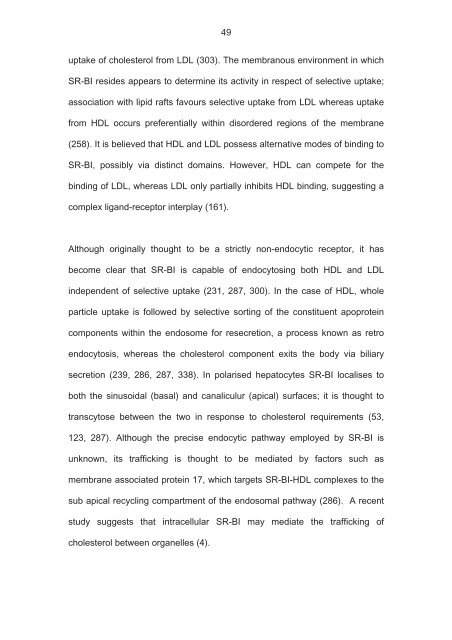The role of scavenger receptor BI in hepatitis - eTheses Repository ...
The role of scavenger receptor BI in hepatitis - eTheses Repository ...
The role of scavenger receptor BI in hepatitis - eTheses Repository ...
You also want an ePaper? Increase the reach of your titles
YUMPU automatically turns print PDFs into web optimized ePapers that Google loves.
49<br />
uptake <strong>of</strong> cholesterol from LDL (303). <strong>The</strong> membranous environment <strong>in</strong> which<br />
SR-<strong>BI</strong> resides appears to determ<strong>in</strong>e its activity <strong>in</strong> respect <strong>of</strong> selective uptake;<br />
association with lipid rafts favours selective uptake from LDL whereas uptake<br />
from HDL occurs preferentially with<strong>in</strong> disordered regions <strong>of</strong> the membrane<br />
(258). It is believed that HDL and LDL possess alternative modes <strong>of</strong> b<strong>in</strong>d<strong>in</strong>g to<br />
SR-<strong>BI</strong>, possibly via dist<strong>in</strong>ct doma<strong>in</strong>s. However, HDL can compete for the<br />
b<strong>in</strong>d<strong>in</strong>g <strong>of</strong> LDL, whereas LDL only partially <strong>in</strong>hibits HDL b<strong>in</strong>d<strong>in</strong>g, suggest<strong>in</strong>g a<br />
complex ligand-<strong>receptor</strong> <strong>in</strong>terplay (161).<br />
Although orig<strong>in</strong>ally thought to be a strictly non-endocytic <strong>receptor</strong>, it has<br />
become clear that SR-<strong>BI</strong> is capable <strong>of</strong> endocytos<strong>in</strong>g both HDL and LDL<br />
<strong>in</strong>dependent <strong>of</strong> selective uptake (231, 287, 300). In the case <strong>of</strong> HDL, whole<br />
particle uptake is followed by selective sort<strong>in</strong>g <strong>of</strong> the constituent apoprote<strong>in</strong><br />
components with<strong>in</strong> the endosome for resecretion, a process known as retro<br />
endocytosis, whereas the cholesterol component exits the body via biliary<br />
secretion (239, 286, 287, 338). In polarised hepatocytes SR-<strong>BI</strong> localises to<br />
both the s<strong>in</strong>usoidal (basal) and canaliculur (apical) surfaces; it is thought to<br />
transcytose between the two <strong>in</strong> response to cholesterol requirements (53,<br />
123, 287). Although the precise endocytic pathway employed by SR-<strong>BI</strong> is<br />
unknown, its traffick<strong>in</strong>g is thought to be mediated by factors such as<br />
membrane associated prote<strong>in</strong> 17, which targets SR-<strong>BI</strong>-HDL complexes to the<br />
sub apical recycl<strong>in</strong>g compartment <strong>of</strong> the endosomal pathway (286). A recent<br />
study suggests that <strong>in</strong>tracellular SR-<strong>BI</strong> may mediate the traffick<strong>in</strong>g <strong>of</strong><br />
cholesterol between organelles (4).

















